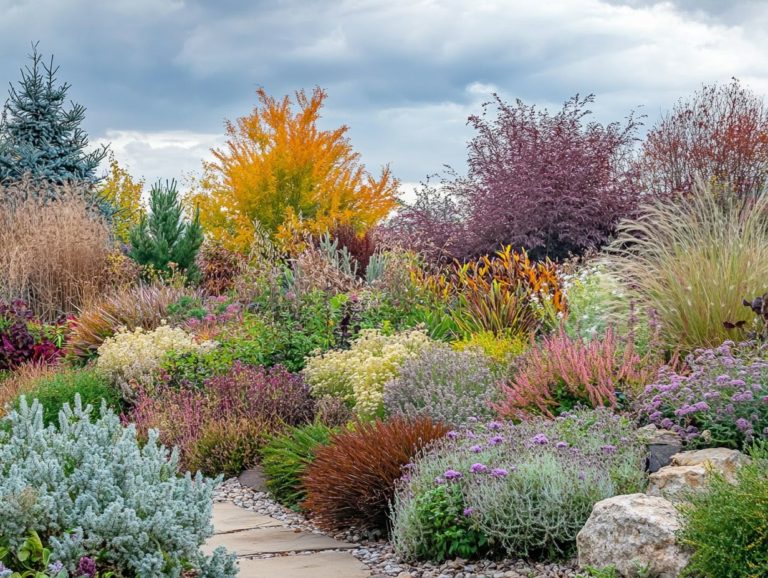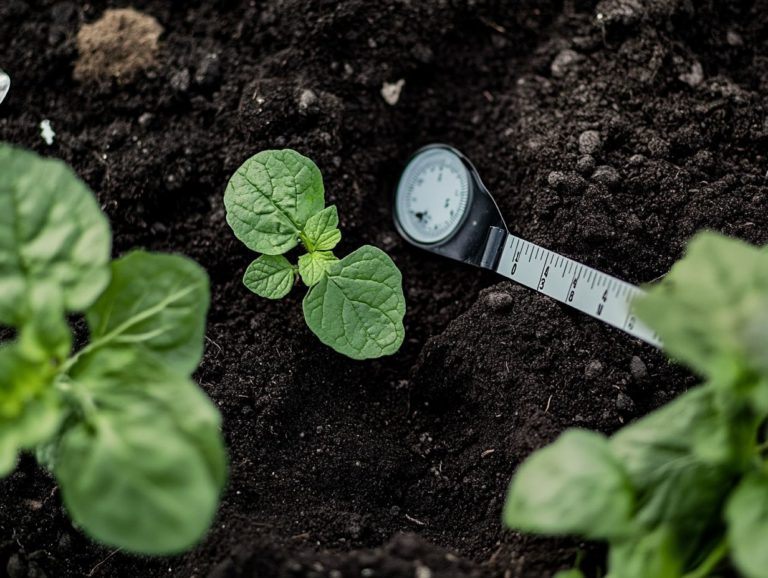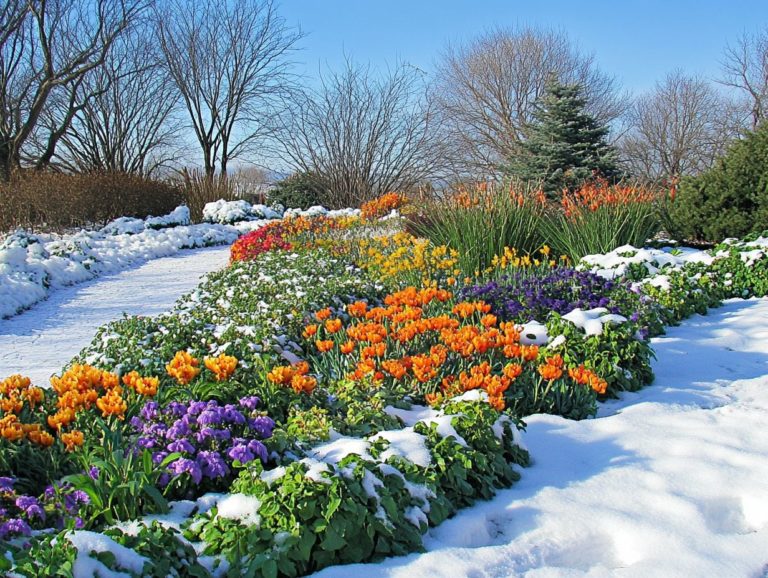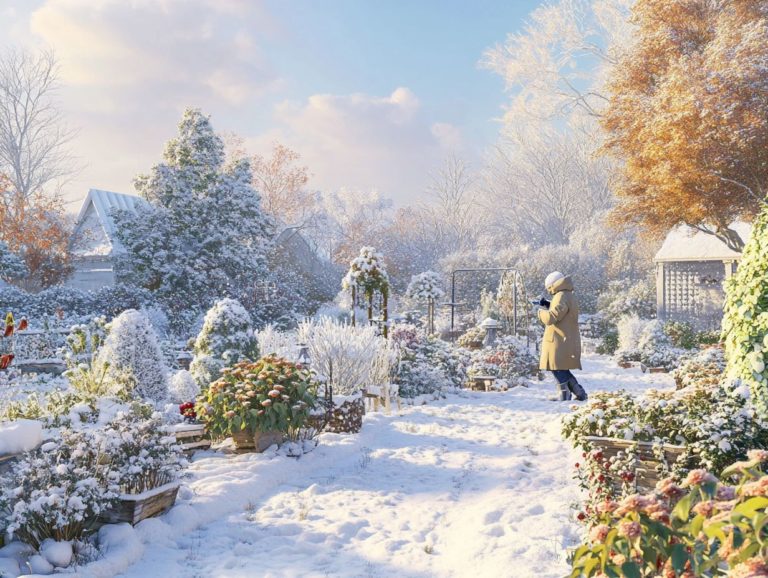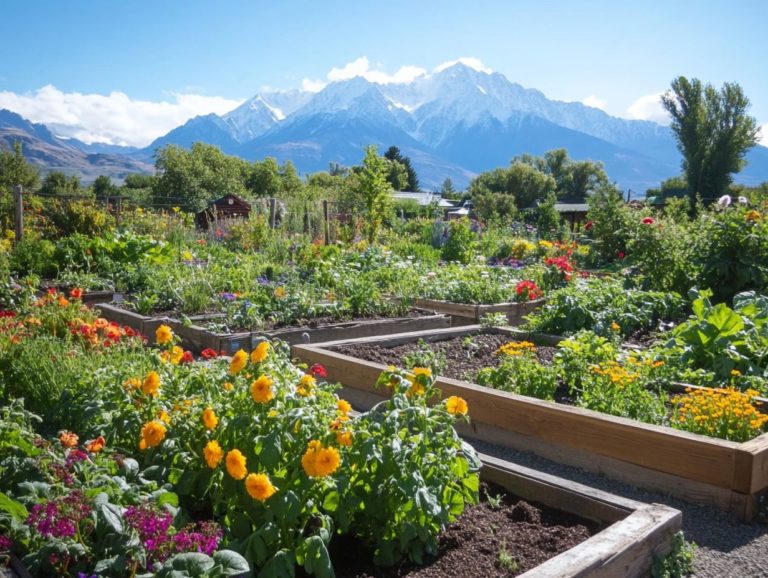Cold-Climate Gardening: Choosing Native Species
Imagine cultivating a garden filled with vibrant colors and fresh produce! Cold-climate gardening offers more than just looks; it presents a remarkable opportunity for you to create sustainable spaces while enjoying various environmental and economic benefits, especially by utilizing techniques such as raised beds and effective seed planting.
By choosing native species that excel in harsh conditions, you can enhance the resilience of your landscape. This article delves into the essentials of cold-climate gardening. It guides you on how to identify native plants, the key factors to consider when selecting the right species, and practical tips to avoid common mistakes.
With tips for planting and nurturing these hardy plants, including season extenders and sheltered areas, you ll be well on your way to creating a flourishing garden, even amidst the chill of winter.
Contents
- Key Takeaways:
- The Benefits of Cold-Climate Gardening
- Choosing Native Species for Cold Climates
- Key Factors for Choosing the Right Plants for Your Cold-Climate Garden
- Common Mistakes to Avoid in Cold-Climate Gardening
- Creating a Successful Cold-Climate Garden
- Frequently Asked Questions
- What is cold-climate gardening?
- Why is choosing native species important in cold-climate gardening?
- What are some benefits of using native species in cold-climate gardening?
- How do I determine which native species are suitable for my cold-climate garden?
- Can I still grow non-native plants in my cold-climate garden?
- Are there any special considerations for maintaining a cold-climate garden?
Key Takeaways:
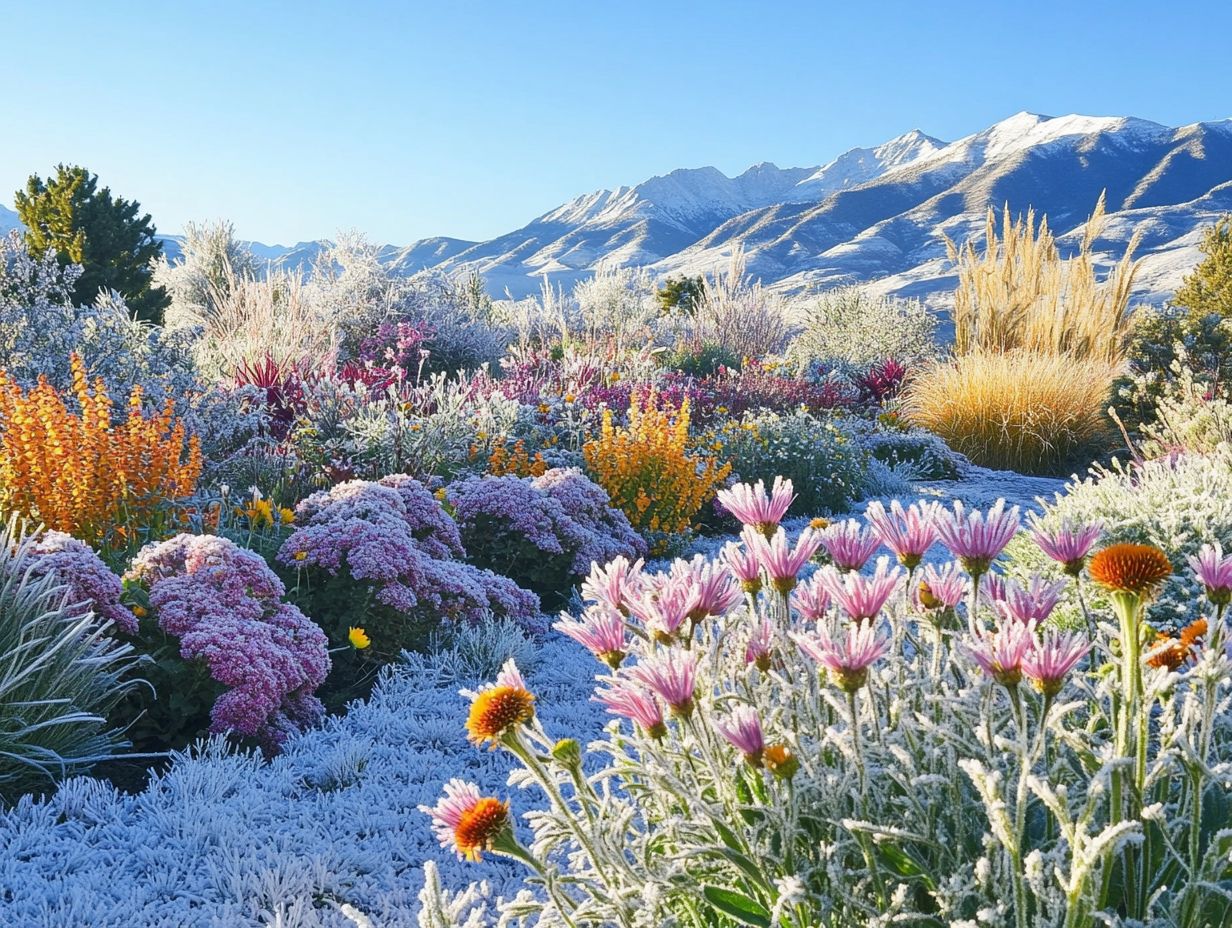
- Native species are well-adapted to thrive in cold climates, making them a smart choice for your garden.
- When selecting plants for your cold-climate garden, consider factors like climate, soil conditions, and plant hardiness to ensure success.
- Avoid common mistakes like overlooking hardiness zones, which indicate the temperature ranges where plants can thrive.
- Don’t forget about maintenance needs to create a successful cold-climate garden.
The Benefits of Cold-Climate Gardening
Cold-climate gardening provides an array of benefits. For those residing in regions like Wyoming or Alaska, it fosters a distinctive connection with the land and offers unique opportunities for creating an herb garden.
You have the chance to cultivate nutrient-rich heirloom seeds and establish flourishing vegetable gardens that support local economies and promote sustainable living. By employing strategies such as raised beds, sheltered areas, and season extenders, you can maximize your growing season while enhancing your yields.
Environmental and Economic Benefits
The environmental benefits of cold-climate gardening are substantial. These include improved soil health, increased biodiversity, and a reduced carbon footprint.
By utilizing local gardening practices, you can significantly contribute to a healthier ecosystem. Economically, you ll enjoy advantages through local food production and community engagement.
For instance, analyzing your soil can uncover nutrient deficiencies, allowing you to optimize growth conditions. This not only enhances your crop yields but also nurtures a healthier ecosystem.
Integrating native plants like Echinacea and Trillium into your garden is not just an aesthetic choice. It provides essential habitats for pollinators while requiring less maintenance and water talk about a win-win for sustainability!
From an economic standpoint, growing local produce reduces reliance on imported goods and creates jobs in your community. Additionally, it encourages participation in cooperative gardening initiatives, fostering a sense of shared purpose and well-being in the neighborhood.
Choosing Native Species for Cold Climates
Choosing native species for cold climates can significantly enhance your gardening success. This is especially true in challenging environments like Wyoming, where the growing season is brief and frost dates can be unpredictable. For more insights, explore sustainable plant choices for cold climates.
By selecting plants that are naturally adapted to these demanding conditions, you ll enjoy better survival rates and experience reduced maintenance.
This thoughtful approach fosters a more resilient ecosystem. For example, plants like the Currant bush help local wildlife and pollinators, making your garden a thriving habitat.
Don’t wait! Start planning your cold-climate garden today for a bountiful harvest next season!
Why Native Species Thrive in Cold Climates
Native species excel in cold climates thanks to their evolutionary adaptations to local environmental conditions. These adaptations make them inherently more resilient to temperature fluctuations and soil variability, critical factors in regions like California.
These plants often showcase unique traits, such as shorter growth forms and deep root systems. These features allow them to anchor securely in the soil and efficiently access moisture during harsh winters, supporting their role in our local ecosystems. Many native plants are also fine-tuned to specific temperature zones, such as the USDA guidelines, meaning they can endure freezing temperatures yet thrive come spring.
For those looking to incorporate these hardy varieties into their gardens, selecting plants for cold climate community gardens is essential, including regionally appropriate species such as Penstemon and Erythronium. Native groundcovers and perennials not only bolster resilience against the elements but, when paired with proper mulching and growing techniques utilizing greenhouses, help retain soil warmth. Grouping plants based on their moisture needs, including consideration for drought-tolerant species, can enhance water efficiency and foster a healthier garden ecosystem.
How to Identify Native Species
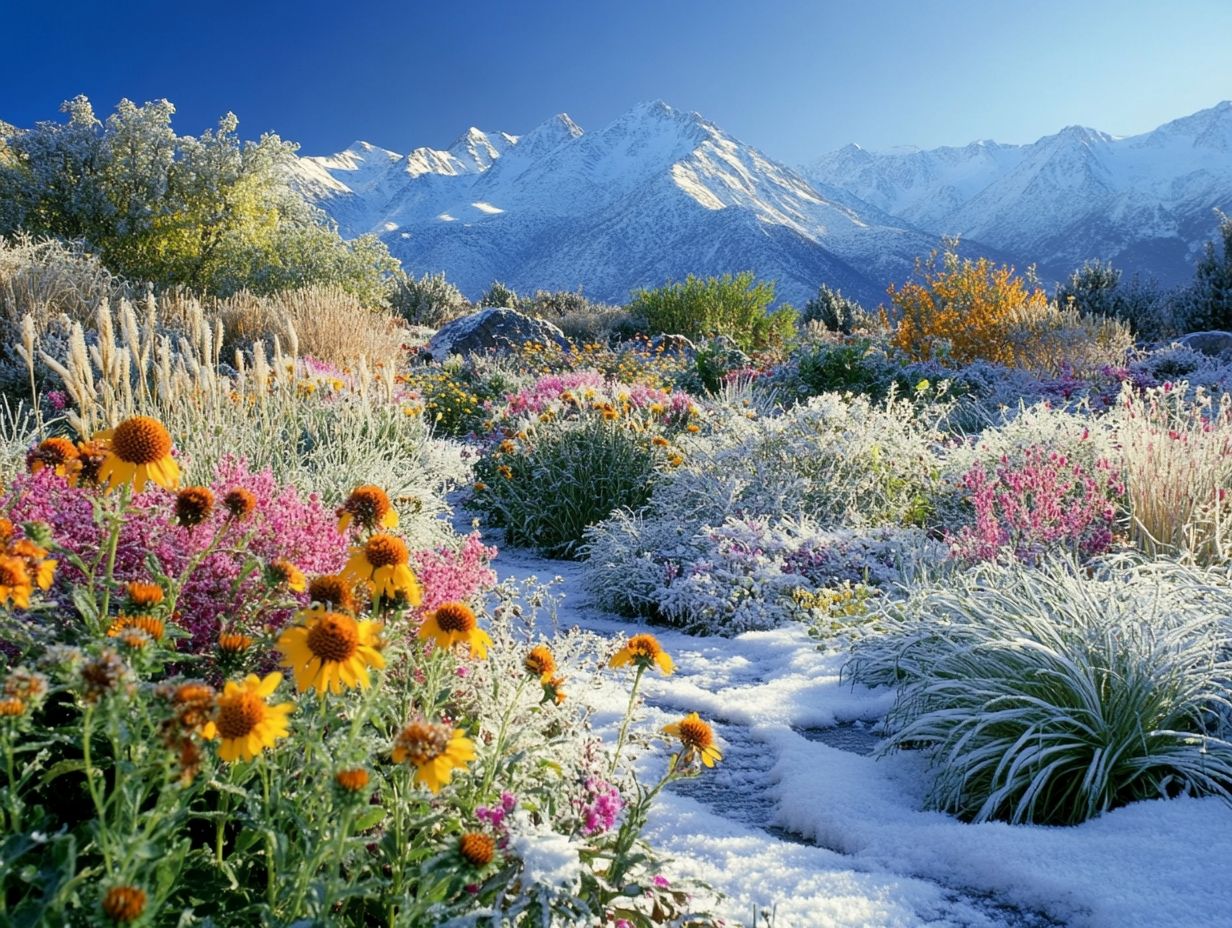
Identifying native species in cold climates, such as Wyoming, can be effectively accomplished through various methods. Start by diving into local gardening resources, exploring plant guides, and tapping into the wealth of community knowledge. Seek insights from local experts like Patricia or Beth Savidge regarding local flora.
Embrace technology by utilizing smartphone apps specifically designed for plant identification. These apps can aid in identifying heirloom seeds and other native plants. They feature extensive databases of native species, including popular varieties like Echinacea, along with detailed descriptions. Simply snap a picture of a plant to receive immediate feedback on its identity, helping you discover whether it fits within local gardening practices.
Engaging with local gardening communities, including organizations like the California Native Plant Society, offers invaluable insights. Experienced gardeners frequently share tips and firsthand experiences tailored to the region, focusing on the best times for planting seeds. Join online forums or attend community workshops that cover essential topics like soil testing. These avenues can significantly enhance your understanding of native plants and their habitats, making the identification process easier and more enjoyable.
Key Factors for Choosing the Right Plants for Your Cold-Climate Garden
When choosing plants for your cold-climate garden, it’s essential to consider several factors, including local advice from gardening centers. Additionally, selecting trees for cold-climate landscaping can greatly enhance your garden. Assess the climate conditions, evaluate the soil quality, and identify the specific hardiness zone of your region. These steps play a crucial role in your planting strategy.
Evaluate carefully! This ensures your garden thrives and produces plenty.
Climate and Soil Conditions
Understanding climate and soil conditions is vital for success in cold-climate gardening. These elements directly impact plant health and productivity, especially during the growing season.
A comprehensive soil test serves as your best ally in determining pH levels and nutrient availability. These factors are crucial for optimizing growth and ensuring a successful herb garden. Temperature fluctuations throughout the day can significantly influence germination rates and root development, particularly for crops planted around Memorial Day. It s essential to monitor these changes closely.
Consider using mulch or row covers and potentially utilizing greenhouses for seedlings to maintain consistent moisture levels in your garden beds. By adapting your practices such as carefully timing your sowing dates and selecting resilient plant varieties like the currant bush you can enhance your chances of cultivating a flourishing garden, even in challenging cold climates.
Plant Hardiness and Adaptability
When gardening in cold climates, planting hardiness and adaptability are crucial factors to consider. These elements are particularly important for plants that thrive in specific USDA hardiness zones, which dictate which species will not just survive but truly thrive in harsh conditions.
Understanding USDA hardiness zones can significantly enhance your ability to select plants that flourish in your specific environment. This knowledge is essential for gardeners in areas like California or Wyoming. These zones serve as a guide, indicating minimum winter temperatures, helping you choose species that are well-suited to your locale and ensuring you select varieties that won’t struggle during the colder months.
For example, native perennials like coneflowers and black-eyed Susans excel in various conditions, making them excellent choices for many zones, including those found in California.
Incorporating practical strategies, such as mulching to protect root systems during frosty months, and selecting the appropriate soil type, will further boost your gardening success in cooler climates. This ensures your plants are ready for winter and early spring growth, allowing them to establish strong root systems and thrive year after year.
Common Mistakes to Avoid in Cold-Climate Gardening
Common mistakes in cold-climate gardening often arise from misunderstanding hardiness zones and the specific maintenance requirements of plants adapted to these regions. Gardeners frequently overlook planting schedules, leading to frustrating and unsuccessful gardening experiences.
Overlooking Hardiness Zones
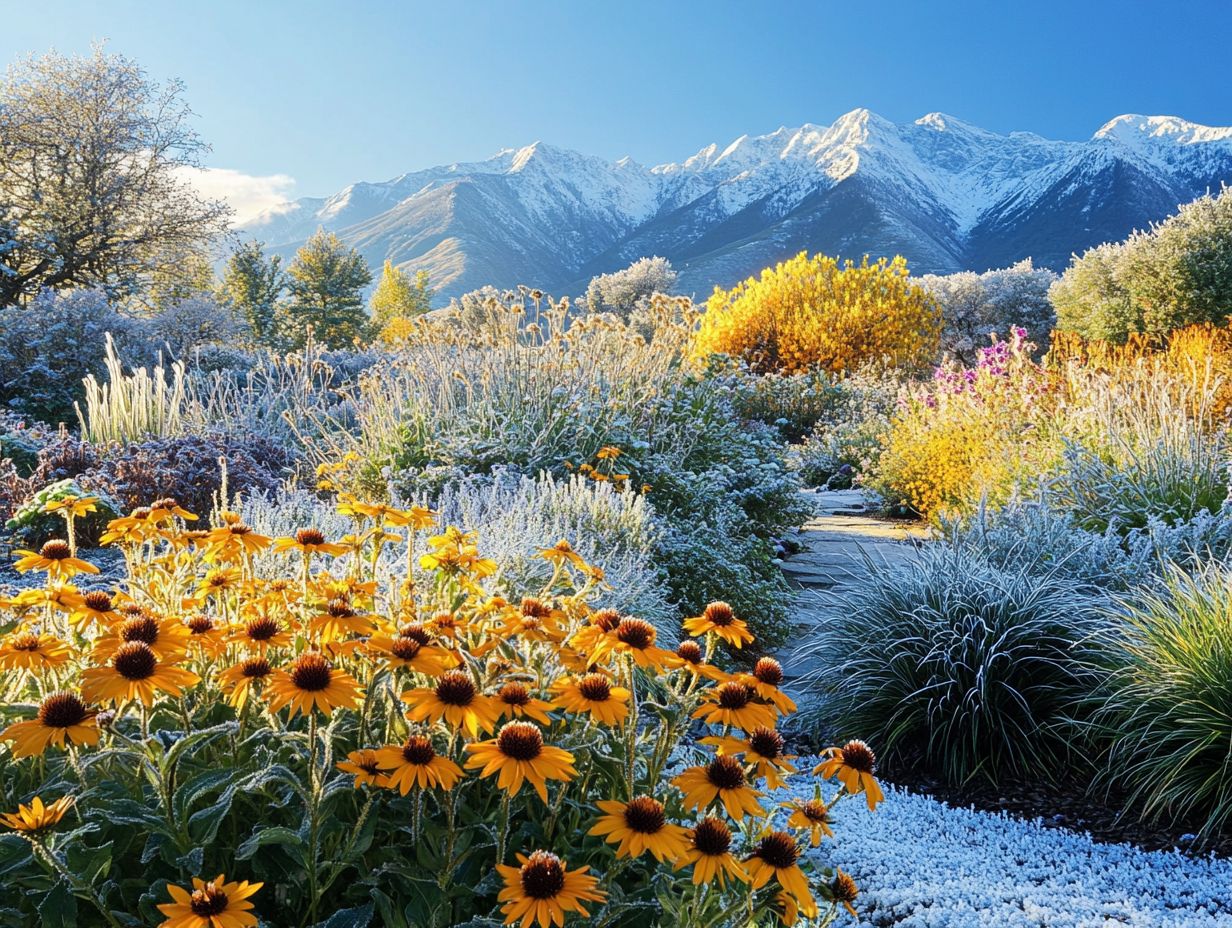
Overlooking hardiness zones is a common pitfall that can result in unfortunate plant choices and ultimately lead to gardening failures in colder climates. If one does not consider local conditions, this essential concept serves as your guiding star, helping you select plants that can truly thrive in your unique environment.
For example, if you are in Zone 5, consider hardy perennials like daylilies or hostas. These should be on your radar, especially when looking for varieties in local gardening stores. In warmer climates, such as Zone 9, you might want to consider more delicate options like hibiscus or bougainvillea, which thrive during warmer months.
Ignoring hardiness zones can jeopardize your plants’ survival and lead to financial setbacks and heartache. This is especially true for novice gardeners who invest in the wrong species, resulting in wasted time and resources.
Not Considering Maintenance Needs
Neglecting the maintenance needs of your chosen plants can create overwhelming challenges, particularly in cold climates like Wyoming and Alaska. This can detract from a productive gardening experience, especially in regions like California that have diverse climates. As you embark on cultivating a flourishing garden, it’s vital to consider the visual charm of your plants, along with the time, effort, and resources you can realistically dedicate to their care.
Choosing low-maintenance species, such as Currant and Currant bush, which thrive in cold climates, can significantly lighten your regular care load. It’s essential to understand the specific needs of your plants think watering frequency, pruning schedules, and disease resistance. This is particularly important for plants recommended by sources like the California Native Plant Society.
By integrating techniques like mulching and companion planting, you can simplify maintenance tasks, ensuring your garden stays vibrant and manageable, even when the cold weather tries to disrupt your plans. You’ll want to start your garden planning today to ensure a vibrant bloom this spring!
Creating a Successful Cold-Climate Garden
Crafting a successful cold-climate garden demands a thoughtful approach that encompasses the best practices for January planting and October preparations. This includes effective planting strategies, meticulous plant selection, and ongoing maintenance practices, all tailored to meet the unique challenges of maintaining Trillium and other delicate species. For more insights, refer to understanding plant needs in cold climates.
By embracing this clear plan, you can cultivate a stunning garden that flourishes despite the cold, helping to mitigate issues during Spring Fever.
Tips for Planting and Maintaining Native Species
Effective planting and maintenance of native species in cold-climate gardens can significantly boost the survival of cold-climate plants such as Erythronium and their productivity. To achieve this, understanding plant selection for cold-climate design is crucial, transforming your space into a lush, thriving oasis.
To achieve this, start by selecting plants for cold-climate rain gardens that can withstand low temperatures and are well-suited to your local conditions, like the Currant bush. Pay attention to factors like soil type and sunlight availability, especially for plants like Echinacea, which thrive in warm areas; these details matter more than you might think.
Implementing proper planting techniques is essential. For instance, digging a wide, shallow hole encourages strong root systems to take hold. Establishing a regular watering schedule to accommodate the short growing seasons typical of Garden Zone 3, especially during dry spells, is crucial to support your plants as they settle in.
Seasonal maintenance, such as mulching during the winter months, is particularly vital for California native species. It can insulate the roots and prevent frost heave, an issue often faced in cold regions like Wyoming. Additionally, summer pruning around Memorial Day promotes robust growth. By adopting these practices, you can create the perfect conditions that nurture the resilience of plants like Trillium, allowing them to flourish even in the harshest conditions. The vigor of your garden improves when you choose native plants suitable for your locale, even in challenging climates.
Frequently Asked Questions
What is cold-climate gardening?

Cold-climate gardening refers to gardening in regions with long, cold winters and short growing seasons. These areas typically have low temperatures and heavy snowfall, making it challenging to grow plants.
Why is choosing native species important in cold-climate gardening?
Choosing native species is important because these plants are adapted to the local climate and soil conditions. For those in colder regions, a guide to native plants for cold climates can help ensure they have a better chance of surviving harsh winters and thriving in short growing seasons.
What are some benefits of using native species in cold-climate gardening?
Using native species can help preserve the local ecosystem, attract and support native wildlife, and require less maintenance and resources to grow.
How do I determine which native species are suitable for my cold-climate garden?
You can consult with local gardening experts or research online to find out which native species are suitable for your cold-climate garden. Additionally, choosing the right grasses can enhance your garden’s resilience. Consider factors like soil conditions, sunlight exposure, and USDA hardiness zones when making your selection.
Can I still grow non-native plants in my cold-climate garden?
While it is recommended to focus on native species, you can still grow non-native plants as long as they can survive in the local climate and do not become invasive.
Are there any special considerations for maintaining a cold-climate garden?
Yes, in addition to choosing native species, you may need to protect your plants from extreme temperatures and heavy snowfall by using mulch, covers, or shelters. To enhance your garden’s resilience, consider what are the best native plants for cold climates. It’s also important to regularly clean up and remove any dead or diseased plants to prevent the spread of pests and diseases.


